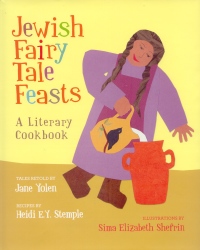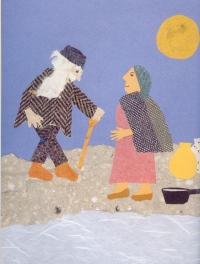| ________________
CM . . .
. Volume XIX Number 31 . . .April 12, 2013
excerpt:
Any book by American writer Jane Yolen is sure to have an instant readership. Owl Moon is her likely her most famous picture book, but she has never rested on her laurels. The talented author of more than 300 titles, including poetry collections, young adult novels and nonfiction for children, Yolen is a natural storyteller. She had received numerous awards over 50 years, all well deserved.
Traditional stories are a valuable treasure that are often rewritten for a modern audience ( think Fiddler on the Roof, an adaptation of a story by Sholem Alecheim) and have timeless lessons. The 18 stories in this collection, each 4-8 pages long, will entertain and educate children between the ages of 9 and 12 about traditional Jewish folktales, parables and fables. Yolen talks about how stories change, depending on who is doing the telling, and admits she has added her own touch to "look for new ways to say old things." She informs the reader about alternative versions of the stories and their origins. There's a lot of humour in the stories as characters trick evil-doers or get their just desserts. Some of the quotes and quips at the beginning of the stories ("Nothing is certain but death and blintzes" Old Jewish Comedy Routine) are best appreciate with an understanding of Jewish humour, but others are taken from the Torah and are appropriate for the story being told. But stories from countries and cultures all over the world are infused with particular words and attitudes, which add to their appeal.
Mizzle, fizzle, Rifka, The word 'kishka' isn't translated, but the reader will be able to figure out that, whatever it means literally, it's bound to hurt when kicked. Stemple's recipes are traditional, but she has tested and tasted to give them her seal of approval. The dishes range from the well-known old style bagels, chicken soup and noodle kugel to the modern shashuka and mini-cheesecakes. Stemple wrote the commentary for each recipe using a chatty, tongue-in-cheek narrative. "A battle rages over matzo brei. Though most people will tell you their way is the only way to cook it, the good news is that there is no wrong way." But there is excellent information that will teach young cooks and bakers about the ingredients (how to deseed a pomegranate without getting stained with the red juice is instructive) and history, too:
Canadian artist Sima Elizabeth Shefrin illustrates the stories and recipes with cloth and collage. She creates a Chagall dream-like effect, the patchwork of materials and sparse images representing the poverty of the Eastern European shtetl inhabitants. They add to the effectiveness of the stories, but Shefirn also uses the same media to illustrate the recipes, where an abstract representation does not make food appealing. Jewish food is as good-looking as it is delicious, and people make decisions about what they will cook or bake from seeing what the finished product looks like. A challah should be shown with gorgeous, golden brown rounded braids, not as beige circles topped with tiny black polka dots for poppy or sesame seeds. A kugel is a mouth-wateringly bright yellow, bubbling with cheese, raisins or cinnamon, not pale yellow with some flecks of white. The matzo lasagna looks like a brown slab between two pieces of cardboard. It's creative, but not tempting. Jewish Fairy Tale Feasts: A Literary Cookbook will make a good gift for children. It's great for reading aloud or alone, curled up in a chair. It's also a good motivator for parents to teach their kids about traditional and contemporary Jewish cooking. The explanations are clear enough that a competent pre-teen can succeed in making most of these dishes with minimal oversight. It will add 'taste' (tam in Yiddish) to a library collection literally a literary treat. Highly Recommended. Harriet Zaidman is a teacher-librarian in Winnipeg, MB.
To comment
on this title or this review, send mail to cm@umanitoba.ca.
Copyright © the Manitoba Library Association. Reproduction for personal
use is permitted only if this copyright notice is maintained. Any
other reproduction is prohibited without permission.
NEXT REVIEW |
TABLE OF CONTENTS FOR THIS ISSUE
- April 12, 2013
AUTHORS |
TITLES |
MEDIA REVIEWS |
PROFILES |
BACK ISSUES |
SEARCH |
CMARCHIVE |
HOME |

 Yolen teams up again with her daughter Heidi Stemple. As well as other books (Unsolved Mysteries from History and the upcoming Bad Girls: Sirens, Jezebels, Murderesses, and Other Female Villains) the mother-daughter duo penned
Yolen teams up again with her daughter Heidi Stemple. As well as other books (Unsolved Mysteries from History and the upcoming Bad Girls: Sirens, Jezebels, Murderesses, and Other Female Villains) the mother-daughter duo penned